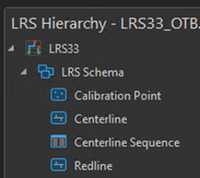- Home
- :
- All Communities
- :
- Products
- :
- ArcGIS Pipeline Referencing
- :
- Pipeline Referencing Blog
- :
- Pipeline Referencing Information Model
Pipeline Referencing Information Model
- Subscribe to RSS Feed
- Mark as New
- Mark as Read
- Bookmark
- Subscribe
- Printer Friendly Page
The ArcGIS Pipeline Referencing Information Model is the core structure for linear referencing data. The package available for download in this blog, can be used to explain the LRS data model as applicable to APR. This is intended to explain and understand the basic building blocks of the solution as detailed below. The package contains the following items:
- File geodatabase containing LRS model and configuration
- LRS report containing schema details and LRS configuration metadata
The model evolves as new capabilities get added. Hence, the following packages are being provided corresponding to major, long-term releases:
- APR Information Model for ArcGIS Pro 3.3: LRS33PR_Package.zip
- APR Information Model for ArcGIS Pro 3.1: LRS31_Package.zip
LRS Model
The LRS Schema is comprised of the following feature classes and tables:
- Centerline: Centerline
- Calibration Point: Calibration_Point
- Redline: Redline
- Centerline Sequence: Centerline_Sequence (table)
The following LRS entities can be added on, as needed for the modelling exercise:
- Networks
- Line Network: Line_Net
- Derived Network: Derived_Net (optional)
- Events
- Point Event: Point_Ev
- Range Event: Range_Ev
- Station Equation Event: Station_Ev (optional)
- Intersections
- Hydrology Intersection: Hydro_Int uses ‘GeoLayers/Rivers’ as the intersecting layer (optional)
LRS Report
The LRS Report is comprised of the following:
- LRS33PR: schema report (HTML, json, PDF, Excel formats)
- lrs33PR_Metadata: LRS configuration metadata (XML format)
Conclusion
You can use APR tools to create or load data to the geodatabase included, to further your understanding and proof of concept efforts. APR’s flexible information model allows you to model your own network, event and intersection feature classes. The package is not intended to be organization specific or implementation ready. However, it does provide the core structure to get you started. More comprehensive data models and their implementation practices can be found at UPDM, PODS and related resources.
You must be a registered user to add a comment. If you've already registered, sign in. Otherwise, register and sign in.



